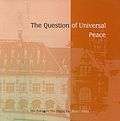Tablet to The Hague
| Texts and scriptures of the Bahá'í Faith |
|---|
  |
| From the Báb |
| From Bahá'u'lláh |
| From `Abdu'l-Bahá |
| From Shoghi Effendi |
The Tablet to The Hague is a letter which `Abdu'l-Bahá wrote to the Central Organisation for Durable Peace in The Hague, The Netherlands on 17 December 1919.
Historical background
When the Central Organization for Durable Peace came together, they published their constitution in newspapers all over the world. It was read by Mr. Ahmad Yazdání who in consultation with Hand of the Cause Mr. Ibn-i-Asdaq wrote a paper to the organization informing them about the Bahá'í Principles and suggesting they seek guidance from Abdu'l-Bahá regarding their aim to establish universal peace.[1] The organization wrote a letter through mr. Yazdání to Abdu'l-Bahá dated February 11, 1916. When the letter arrived Abdu'l-Bahá revealed the Tablet to the Hague which was delivered in person to the organization by mr/.Yazdání and mr. Ibn-i-Asdaq in June 1920. The letter was dated February 11th 1916, but this letter did not arrive for many years due to the war.[2] By the time the letter arrived the organization had already been disbanded in June 1919 after the signing of the treaty of Versailles.[3]
Content of the Tablet
In the tablet, `Abdu'l-Bahá gives an overview of Bahá'í principles, which include the following:
- Declaration of universal peace.
- Independent investigation of reality.
- Oneness of humanity.
- Religion must be the cause of fellowship and love.
- Religion must be in conformity with science and reason.
- Abandonment of religious, racial, political, economic and patriotic prejudices.
- One universal language.
- Equality of women and men.
- Voluntary sharing one's property.
- Man's freedom from the captivity of the world of nature.
- Religion is the ideal safeguard.
- Material civilization should be combined with Divine civilization.
- Promotion of education.
- Justice and right.
He declares that the League of Nations is "incapable of establishing universal peace", and calls for the establishment of a Supreme Tribunal, representing all countries:
| “ | When the Supreme Tribunal gives a ruling on any international question, either unanimously or by majority rule, there will no longer be any pretext for the plaintiff or ground of objection for the defendant. In case any of the governments or nations, in the execution of the irrefutable decision of the Supreme Tribunal, be negligent or dilatory, the rest of the nations will rise up against it, because all the governments and nations of the world are the supporters of this Supreme Tribunal. | ” |
Second Tablet to the Hague
The organization wrote a response to the Tablet to the Hague on the 12th of June 1920. Abdu'l-Baha responded with a second, shorter tablet to the Hague on the 12th of July 1920.[4][5]
Notes
- ↑ Quddusi, Sima. "Abdu'l-Baha's Tablets to the Central Organization for a Durable Peace at the Hague".
- ↑ Balyuzi, Eminent, p. 176.
- ↑ "Central Organization for a Durable Peace [Organisation Central pour une Paix Durable] Collected Records, 1914-1919".
- ↑ Balyuzi. Abdu'l-Baha - The Centre of the Covenant. p. 440.
- ↑ Abdu'l-Bahá (July 1920). "Second Tablet to the Committee of Universal Peace at The Hague". Star of West. 11 (17): 288.
References
- `Abdu'l-Bahá (1999) [1919]. The Question of Universal Peace - The Tablet to The Hague by `Abdu'l-Bahá. Den Haag, The Netherlands: Stichting Bahá'í Literatuur. ISBN 90-70765-43-8.
- Balyuzi, H.M. (2001). `Abdu'l-Bahá: The Centre of the Covenant of Bahá'u'lláh. Oxford, UK: George Ronald. ISBN 0-85398-043-8.
- Balyuzi, H.M. (1985). Eminent Bahá'ís in the time of Bahá'u'lláh. Oxford, UK: George Ronald. ISBN 0-85398-152-3.
